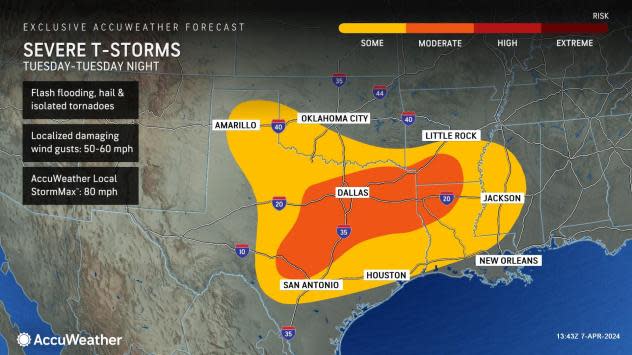Total solar eclipse cloud forecast: Will clouds spoil your view?
The final countdown is underway! In just a few hours, the moon's shadow casts part of the United States into darkness for a few fleeting moments, and the deciding factor of whether or not people in the path of totality see the event may boil down to one thing: clouds.
The eclipse takes place on Monday, April 8, and for areas in the path of totality, it will be an afternoon affair, with the exact timing varying depending on your location. People outside of the path of totality will still be able to see a partial solar eclipse as long as clouds don't spoil the show.
AccuWeather's latest total solar eclipse cloud forecast is looking promising for some but concerning for others, AccuWeather lead long-range forecaster Paul Pastelok said. Most places in the vicinity of the path of totality will have to deal with some level of clouds, whether high or low. But there are some areas with good viewing expected.
 |
The best viewing near the path of totality is from Missouri to Ohio and most of New England. Some high clouds will block the viewing at times from Dallas to Amarillo, but the skies will still offer a decent showing.
"The clearing zone is pushing quickly across Indiana and Ohio this morning. However, some high clouds will continue to streak south to north in this region," Pastelok said. "Viewing looks good for cities like Indianapolis, Detroit, Cleveland and possibly improving in Pittsburgh during the eclipse."
The best areas to watch with more sunshine will be eastern and northern New England, eastern Carolinas and Georgia, and a narrow band from southern New Mexico, central Plains and Ohio Valley. In addition, the viewing looks better in Florida and California, away from the path of totality.
"Major cities like Los Angeles, El Paso, New York City, Boston and Raleigh should all have nice views of the eclipse from start to finish," Pastelok said.
Places along or near the path of totality with more adverse viewing conditions due to low to mid-level clouds are from southeastern Texas to western and central Pennsylvania and parts of western and central New York state.
"Other areas with poor viewing conditions will be from Wisconsin westward through South Dakota and Nebraska to Washington and Oregon," AccuWeather long-range meteorologist Joe Lundberg explained.
In addition to the cloud forecast, there are a few factors involved in the weather pattern after the eclipse that could affect those traveling from viewing locations. Strong winds, dangerous lightning strikes, hail and perhaps a few tornadoes could threaten those traveling back home Monday night and Tuesday.
 |
Showers and drenching thunderstorms can occur across east Texas and the lower Mississippi Valley on Monday and slowly move northward into southern Oklahoma later in the day and night. Strong winds, dangerous lightning strikes, hail and perhaps a few tornadoes could threaten those traveling home from eclipse viewing the night of April 8 and during the day of April 9. Areas along and north of Interstate 10 in Texas may have to deal with severe thunderstorms during this period.
AccuWeather Senior Director of Forecasting Operations, Dan DePodwin is urging eclipse travelers to be aware of their surroundings. "With so many people traveling to unfamiliar areas and camping or staying in an RV, it's important to take a few minutes to locate your nearest storm shelter. It may be a sturdy restroom building, campground office, a nearby public storm shelter, or even a 24-hour retail store," he said.
 |
The slow-moving storms can lead to flooded roadways, especially along interstates 10, 20 and 30 from central Texas to the western Tennessee Valley during this period. Flooding downpours can impact interstates 20, 30 and 40 across northeastern Texas, southeastern Oklahoma, Arkansas, Louisiana,
Kentucky and Tennessee Monday night into Tuesday.
Want next-level safety, ad-free? Unlock advanced, hyperlocal severe weather alerts when you subscribe to Premium+ on the AccuWeather app. AccuWeather Alerts™ are prompted by our expert meteorologists who monitor and analyze dangerous weather risks 24/7 to keep you and your family safer.






